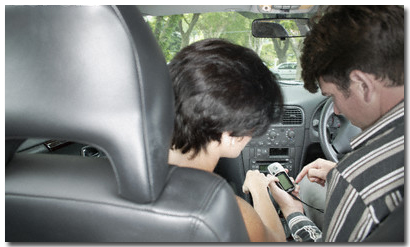|
|
 |
Knowledge Is Key
For Intelligent Decisions
Satellite Logic is a leading,
authoritative source of information in
the Satellite Industry. Located in the
heart of the Silicon Valley, Satellite
Logic provides one of the most
valuable and comprehensive
knowledge bases on the Satellite
market! This is a primary Worldwide
information center which enables our
clients to analyze, evaluate, inquire
and select their best tailored
solutions. Our company sets the
industry standards for targeted
buying leads, reflecting a dramatic
advance over traditional marketing
solutions.
|
|
|
 |

The main objective of the car navigation system is to tell you precisely
where you are and how to get where you need to go. Specially if you
need to travel through a large city, navigate your way back to a hotel
through a residential area with a confounding number of one-way
streets, or looking for a hotel in a local village.
A car with an integrated navigation system that uses Global
Positioning System satellites will do all that. A good navigation
system should include an easy-to-understand interface, with a good
software. It should be easy to operate by the most techno-phobic
people, without taking a preliminary lesson.
But how do you choose a good GPS system? Well, truth is it's not that
easy. First, you have to evaluate how frequently you'll be using it.
Inexpensive systems simply plug in to your car's cigarette lighter and
are small enough to store in your glove compartment, but they're not
as user-friendly as the more expensive systems. Then, you'll have to
take into consideration the interior of your car. Some systems come
with a monitor that displays a map, commonly installed on the
dashboard or on a pedestal extending from the dashboard. Problem
is that in some cars such an installation may block air vents or make
it somewhat uncomfortable for a passenger to enter or exit the
vehicle or sit in the passenger seat.
Another important thing to think about is how will you reach your
destination. The best choice would be a system that features multiple
ways of getting to your destination. This can include by address, by
intersection, by a personal address book or via a location selected
directly from the map. Look for a system that gives you vocal as well
as graphical directions. The systems that use a map and monitor
include arrows that show you the direction of a turn and also indicate
where your car is on the map in relation to the destination. Other
systems use the head unit or radio to display the name of the street
on which you are to make a turn or on which you are traveling. Both
of these systems also give you verbal directions as you approach a
turn.

Just a few years ago, adding a navigation system to your vehicle
meant purchasing bulky components that required complex
installation and the use of multiple CD-ROMs or DVD-ROMs to
download the appropriate maps. Nowadays, many navigation
systems come pre-loaded with maps and features designed to suit
just about any budget and level of use. But besides detecting location
and directing you to the desired location, an effective car navigation
system will include point of interest data. Most systems include
locations of airports, taxis, ATMs and banks, restaurants, hotels and
so on. These are highly important tools, so choose a system that
offers updates of the point-of-interest data.
Once you've deiced which system to buy, you'll have to determine
whether you want an in-dash setup that preserves your car's factory
look, a plug-and-play GPS that is easy to use and install, or a
handheld GPS that you can use in the mountains, on the water, and
in your car.
If you want to maintain the factory look of your dash and add the
convenience of a large fold-out monitor, look for an in-dash navigation
system. A typical in-dash navigation system consists of a car stereo
with a built-in monitor (ranging from 6-1/2" to 7"), a hideaway
connection box that contains A/V inputs and outputs, and an external
GPS antenna. The stereo mounts in the factory stereo slot in your
dash. The hideaway box is usually mounted behind the dash or under
a front seat. In addition to CD playback and AM/FM reception, most
in-dash systems include DVD playback, so you can watch a movie on
the built-in screen when parked. Installation of an in-dash system can
be complex, as they require connection to power, ground, the vehicle
speed sensor, and the parking brake.
Compact and easy to use, plug-and-play GPS receivers are ideal for
anyone who wants the convenience of in-car navigation without the
hassle of a permanent installation. These portable units attach
quickly to the windshield or dash and use a simple cigarette lighter
adapter to draw power, which makes it easy to transfer them from
vehicle to vehicle. Featuring bright color screens that range from 3.5"
to 7", most plug-and-play GPS receivers also include touchscreen
controls, voice prompts, a built-in speaker, and an integrated GPS
antenna. Enjoy!
|
|
|
|
